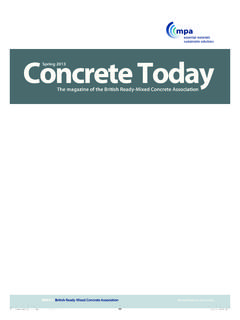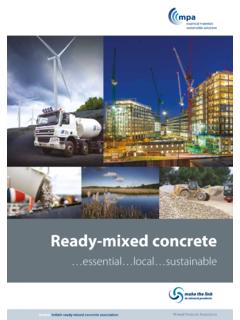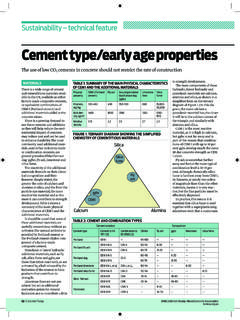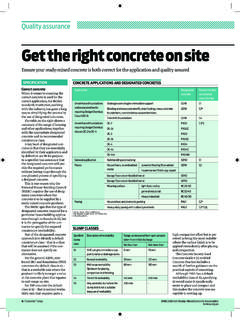Transcription of TR52 – Plain formed concrete finishes - BRMCA
1 JUNE 2015 concrete 11 SOCIETY JUNE 2015 concrete 11 DEAR SIR,THE British Standard concrete Committees for concrete and concrete production and testing met on 22 April 2015 and approved the British Standard for concrete (BS 8500(1)) 3rd edition for publication. The date of publication is April 2015 but the Standard will not come into effect until 30 June of the revision is to fully align with the European Standard for concrete (EN 206(2)) published in 2013 but it has also been aligned with other Standards that have been revised since 2006. Aspects of note are: Changes to align with the European Standard for Aggregate for concrete (EN 12620(3)), including alignment with the European Standard for the classification of coarse recycled aggregates (EN 933-11(4)).
2 Making it clearer that product conformity certification is a requirement for designated concrete and that the certification conforms to minimum requirements as proposed by QSRMC and the BSI Kitemark Scheme for Ready-Mixed concrete . The inclusion of designated cement-bound CB concrete suitable for vibrating plate or roller compaction to a target density. This covers a range of dry-lean and roller-compacted British concrete Standard (BS 8500) 3rd edition published April 2015 READERS LETTERSPUBLISHER: THE concrete SOCIETY, APRIL 2015 ISBN: 978-1-904482-84-0 PRICE: 60, 46 PPThere are many circumstances in which a Plain formed finish is appropriate for concrete surfaces of buildings and civil engineering structures.
3 These range from prominent and highly visible locations, where the Plain formed surface is the final visual or architectural finish, to locations where the finish is not of critical importance because it will only be visible from a distance or because its environment is Plain formed concrete finish can be specified to meet a particular function or durability requirement. Standards and Specifications provide guidance on specifying Plain formed concrete finishes and some describe how they may be achieved; however, they do not illustrate examples of these Plain first edition of TR52 Plain formed concrete finishes was first published in 1999. Since its publication many references to concrete finishes have changed, in particular BS 8110 Structural use of concrete , which has been withdrawn, and the publication of the European Standard BS EN 13670 Execution of concrete structures(1).
4 On the back of these changes many specifications have been second edition of the Technical Report has been published following a comprehensive review of the first edition. The report compares the main specifications in current use, but it does not set out to stipulate how Plain formed concrete finishes should be produced. It also illustrates 20 Plain formed concrete finishes on actual concrete structures, with photographs taken especially under controlled conditions. The examples were all considered to meet their particular specifications; thus, they provide a reference to the quality of work being achieved in the building and civil engineering industry. Details of the concrete mix proportions, specifications and the type of formwork used are given with each illustrated are some of the CONSTRUCT reference panels, now described in line with BS EN 13670, some of the CBDG reference panels in line with Highways England s Specification for Highway Works(2) and also some high-strength concrete reference BarnesThe concrete SocietyTR52 Plain formed concrete finishespecification1.
5 BRITISH STANDARDS INSTITUTION, BS EN 13670. Execution of concrete structures. BSI, London, HIGHWAYS ENGLAND. Manual of Contract Documents for Highway Works Volume 1 Specification for Highway Works. Available at: , amended December BRITISH STANDARDS INSTITUTION, BS 8500. concrete . Complementary British Standard to BS EN 206. Part 1 Method of specifying and guidance for the specifier. Part 2 Specification for constituent materials and concrete . BSI, London, April BRITISH STANDARDS INSTITUTION, BS EN 206. concrete . Specification, performance, production and conformity. BSI, London, December 2013 incorporating corrigendum May BRITISH STANDARDS INSTITUTION, BS EN 12620. Aggregates for concrete . BSI, London, 2002+A1 BRITISH STANDARDS INSTITUTION, BS EN 933.
6 Tests for the geometrical properties of aggregates. Part 11 Classification test for the constituents of coarse recycled aggregate. BSI, London, 2010, incorporating corrigendum November BRITISH STANDARDS INSTITUTION, BS EN 14227-1. Hydraulically bound mixtures. Specifications. Cement bound granular mixtures. BSI, London, BRITISH STANDARDS INSTITUTION, BS 6349-1-4. Maritime works. General. Code of practice for materials. BSI, London, specified by characteristic strength and using cements and combinations outside the scope of EN 14227-1(5). Durability requirements for seawater exposure aligned to the maritime Standard BS 6349-1-4:2013(6). Modified requirements for concrete to resist freezing and thawing.
7 The use of lower d and upper D by the specifier to define the required upper and lower size of the coarsest aggregate. Replace references to sulfate-resisting Portland cement by the nomenclature of the European equivalent cements CEM I+SR0 and CEM I+SR3. Guidance for the specifier on the maximum time between placing layers and some guidance with respect to concrete for geotechnical works. Recommendations for slump-flow identity testing and consistence retention testing. The deletion of the interlinked indexes in BS 8500-1 and BS 8500-2 with requirements in EN 206. Essentially this has been replaced by a new BS 8500-2 Annex D that lists the links between the British and European concrete A ClearChairman B/517 concrete , chairman B/517/1 concrete production and testing, director BRMCA








